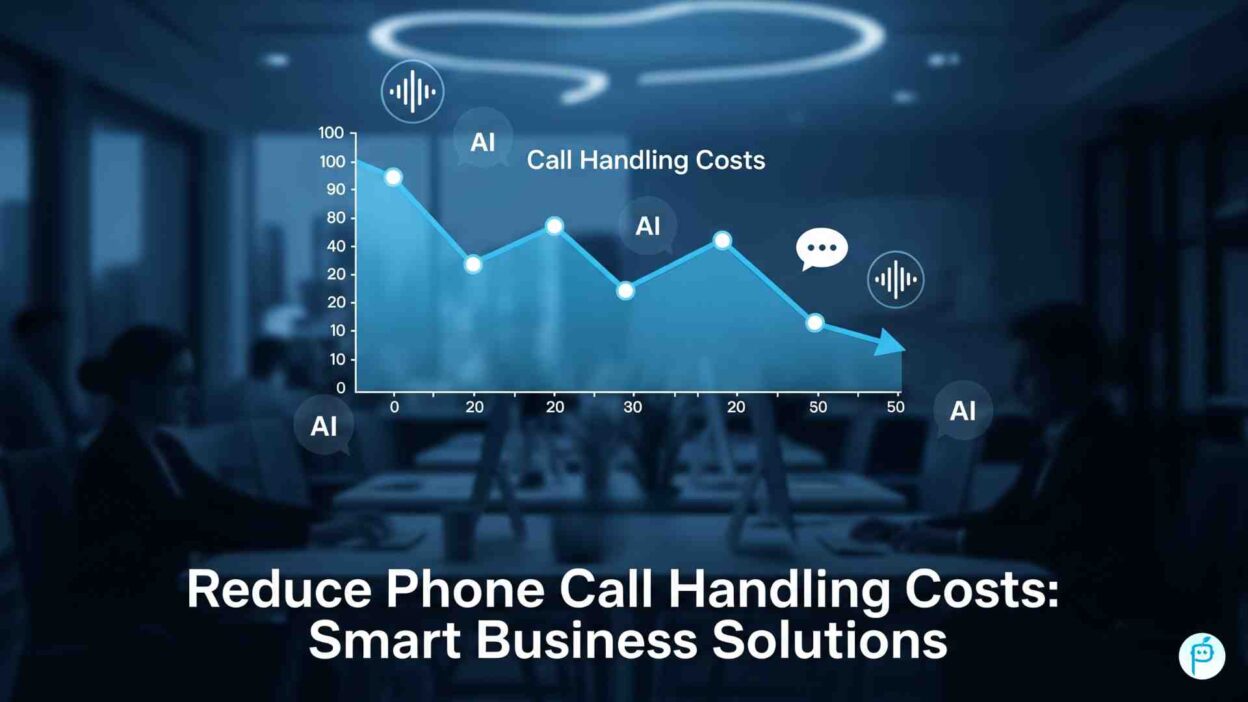Business phone expenses drain operational budgets. Call handling costs increase annually. Traditional phone systems require expensive infrastructure. Staff salaries represent significant overhead.
Table of Contents
Modern companies seek cost-effective alternatives. Technology offers innovative solutions. Smart systems reduce operational expenses. Automation streamlines call management processes.
This comprehensive guide explores cost reduction strategies. You’ll discover proven methods. Learn about technology solutions. Understand implementation approaches for maximum savings.
Understanding Phone Call Handling Expenses
Phone call handling involves multiple cost components. Staff salaries represent the largest expense. Training programs require substantial investment. Equipment purchases add significant costs.
Infrastructure maintenance consumes resources. Phone system upgrades demand capital. Software licensing fees accumulate monthly. Support contracts increase operational expenses.
Hidden costs impact profitability. Idle time reduces productivity. Inefficient routing wastes resources. Poor call quality affects customer satisfaction.
Peak hour staffing creates overtime expenses. Holiday coverage requires premium pay. Night shift operations increase costs. Weekend support adds budget pressure.
Technology Solutions to Reduce Phone Call Handling Costs
Automated Call Routing Systems
Intelligent routing eliminates human intervention. Calls reach appropriate departments automatically. Skill-based routing connects customers with qualified agents. Time-based distribution optimizes staff utilization.
Interactive Voice Response (IVR) systems handle routine inquiries. Customers get instant answers. Common questions receive automated responses. Complex issues route to human agents.
Call queuing manages peak periods efficiently. Hold music maintains professional atmosphere. Estimated wait times set proper expectations. Callback options prevent customer frustration.
Dynamic routing adjusts to real-time conditions. Busy agents receive overflow protection. Available representatives get priority calls. Load balancing optimizes performance.
Cloud-Based Phone Systems
Cloud technology eliminates hardware investments. Monthly subscriptions replace capital expenses. Scalability adjusts to business needs. Geographic expansion becomes cost-effective.
Maintenance responsibilities shift to providers. Software updates happen automatically. Security patches install seamlessly. Technical support includes comprehensive coverage.
Remote work capabilities reduce facility costs. Home offices eliminate overhead. Distributed teams operate efficiently. Travel expenses decrease significantly.
Integration features connect business systems. CRM platforms sync customer data. Help desk software tracks interactions. Analytics tools measure performance.
AI-Powered Call Automation
Artificial intelligence transforms call handling. Chatbots manage simple inquiries. Voice assistants process routine requests. Natural language processing understands customer needs.
Machine learning improves over time. Conversation patterns get analyzed. Response accuracy increases continuously. Customer satisfaction metrics guide improvements.
24/7 availability eliminates overtime costs. Night shift coverage becomes unnecessary. Weekend operations continue automatically. Holiday periods maintain service levels.
Multilingual support serves diverse customers. Translation services break language barriers. Cultural sensitivity improves communication. Market expansion opportunities increase.
Strategies to Reduce Phone Call Handling Costs
Staff Optimization Techniques
Cross-training creates versatile employees. Multiple skills reduce staffing needs. Flexible schedules optimize coverage. Part-time positions handle peak periods.
Performance metrics guide resource allocation. Productivity tracking identifies inefficiencies. Call volume analysis predicts staffing needs. Quality scores highlight training requirements.
Outsourcing options reduce internal costs. Third-party providers offer specialized services. Variable cost structures align with usage. Expertise access improves service quality.
Remote work arrangements cut facility expenses. Office space requirements decrease. Utility costs reduce significantly. Equipment needs become minimal.
Process Improvement Methods
Standardized procedures reduce training time. Documented workflows ensure consistency. Best practices guide agent behavior. Quality standards maintain service levels.
Call scripting improves efficiency. Approved responses ensure accuracy. Compliance requirements get met consistently. New agent onboarding becomes faster.
Knowledge base systems provide instant access. Information retrieval happens quickly. Common solutions get documented. Problem resolution accelerates significantly.
First-call resolution focuses efforts. Repeat calls create additional costs. Proper training reduces callbacks. Customer satisfaction improves dramatically.
Technology Integration Benefits
Unified communications platforms combine channels. Email integration reduces phone volume. Chat systems handle simple inquiries. Social media channels provide alternatives.
CRM integration provides customer context. Previous interactions guide conversations. Purchase history informs discussions. Preferences shape service delivery.
Analytics platforms measure effectiveness. Call volume trends guide planning. Cost per call calculations reveal efficiency. ROI metrics validate investments.
Mobile applications extend functionality. Customers access self-service options. Account management becomes self-directed. Support requests decrease significantly.
Outsourcing and Third-Party Solutions
Call Center Outsourcing
Professional call centers offer cost advantages. Economies of scale reduce per-call costs. Specialized expertise improves service quality. Advanced technology includes comprehensive features.
Global providers offer 24/7 coverage. Time zone differences enable round-the-clock service. Language capabilities serve international markets. Cultural knowledge enhances communication.
Flexible pricing models align costs with usage. Pay-per-call structures eliminate fixed expenses. Monthly subscriptions provide predictable budgets. Volume discounts reward high usage.
Performance guarantees ensure service levels. Service level agreements define expectations. Penalty clauses protect customer interests. Regular reporting maintains transparency.
Virtual Assistant Services
Virtual assistants handle routine calls. Appointment scheduling becomes automated. Information requests receive prompt responses. Basic inquiries get resolved quickly.
Professional training ensures quality service. Industry knowledge improves interactions. Communication skills maintain standards. Technology proficiency enables efficiency.
Cost structures remain predictable. Hourly rates provide budget certainty. Project-based pricing aligns with needs. Retainer agreements ensure availability.
Scalability accommodates business growth. Additional capacity deploys quickly. Seasonal adjustments happen seamlessly. Peak period support prevents bottlenecks.
Answering Service Providers
After-hours coverage extends availability. Emergency calls receive proper handling. Message taking preserves important information. Urgent issues get escalated appropriately.
Professional operators maintain brand image. Scripted responses ensure consistency. Courteous service protects reputation. Accurate information prevents confusion.
Bilingual services expand market reach. Multiple language support serves diverse customers. Cultural sensitivity improves satisfaction. International business opportunities grow.
Integration capabilities connect existing systems. CRM platforms sync customer data. Calendar applications coordinate appointments. Email systems deliver messages promptly.
Self-Service and Automation Options
Interactive Voice Response Systems
IVR technology handles routine inquiries automatically. Account balance requests get instant responses. Payment processing happens without human intervention. Order status updates provide immediate information.
Menu-driven navigation guides customers. Logical flow structures improve usability. Voice recognition enables natural interaction. Touch-tone options provide alternatives.
Database integration provides accurate information. Real-time data ensures current responses. Inventory systems reflect availability. Customer records include recent changes.
Customization options match business needs. Greeting messages reflect brand personality. Menu options align with services. Hold music maintains professional atmosphere.
Customer Self-Service Portals
Online portals reduce phone call volume. Customers access accounts independently. Common tasks become self-directed. Information retrieval happens instantly.
Knowledge bases provide comprehensive support. FAQ sections address frequent questions. Video tutorials demonstrate solutions. Step-by-step guides walk through processes.
Mobile applications extend functionality. Smartphone access enables anywhere service. Push notifications provide proactive updates. Location-based services offer relevant information.
Analytics track usage patterns. Popular content gets prioritized. Problem areas receive attention. User feedback guides improvements.
Chatbot Integration
AI-powered chatbots handle simple inquiries. Natural language processing understands requests. Automated responses provide instant information. Complex issues escalate to human agents.
Website integration captures visitors. Proactive chat offers assistance. Common questions receive immediate answers. Lead generation opportunities increase.
Multi-channel deployment expands reach. Social media platforms include chat features. Mobile apps provide messaging options. Email systems offer automated responses.
Learning algorithms improve performance. Conversation history guides development. User feedback shapes responses. Success metrics validate effectiveness.
Performance Measurement and Optimization
Key Performance Indicators
Call volume metrics track demand patterns. Peak hour analysis guides staffing decisions. Seasonal trends inform capacity planning. Growth projections support budgeting.
Cost per call calculations reveal efficiency. Labor costs include comprehensive expenses. Technology investments spread over time. ROI metrics validate spending decisions.
Customer satisfaction scores indicate service quality. First-call resolution rates measure effectiveness. Average handle time shows efficiency. Abandonment rates highlight problems.
Agent performance metrics guide improvements. Productivity tracking identifies training needs. Quality scores ensure standards. Utilization rates optimize scheduling.
Cost Analysis Methods
Total cost of ownership includes all expenses. Initial investments spread over useful life. Ongoing costs accumulate over time. Hidden expenses get identified systematically.
Comparative analysis evaluates alternatives. Internal costs compare with outsourcing. Technology solutions measure against staffing. ROI calculations guide decisions.
Activity-based costing reveals true expenses. Call handling costs get allocated accurately. Support functions include proportional charges. Overhead expenses get distributed fairly.
Break-even analysis determines viability. Volume thresholds identify profitability. Pricing strategies align with costs. Profit margins guide business decisions.
Continuous Improvement Strategies
Regular reviews identify optimization opportunities. Performance trends guide adjustments. Customer feedback shapes improvements. Technology advances enable enhancements.
Process refinement reduces inefficiencies. Workflow optimization streamlines operations. Training programs address skill gaps. Quality initiatives maintain standards.
Technology updates improve capabilities. Software upgrades enhance functionality. Hardware improvements increase performance. Integration opportunities expand features.
Benchmarking compares industry performance. Best practices guide implementation. Competitive analysis reveals opportunities. Innovation drives continuous improvement.
Implementation Planning and Execution
Assessment and Planning
Current state analysis identifies opportunities. Call volume patterns reveal demand. Cost structures show expense categories. Performance metrics highlight problems.
Future state vision guides transformation. Objectives define success criteria. Timelines establish implementation schedules. Resource requirements determine budgets.
Gap analysis identifies necessary changes. Technology needs get specified. Skill requirements determine training. Process improvements get documented.
Risk assessment identifies potential issues. Mitigation strategies address concerns. Contingency plans prepare for problems. Success factors ensure achievement.
Technology Selection
Vendor evaluation ensures proper fit. Feature comparisons guide decisions. Cost analysis determines value. Reference checks validate claims.
Pilot programs test effectiveness. Limited scope reduces risks. Performance validation confirms capabilities. User feedback guides adjustments.
Integration planning prevents problems. Existing systems require compatibility. Data migration preserves information. Testing procedures ensure functionality.
Training programs build competency. User education accelerates adoption. Administrator training ensures maintenance. Ongoing support maintains effectiveness.
Change Management
Communication strategies address concerns. Stakeholder engagement builds support. Training programs develop skills. Incentive structures motivate adoption.
Phased rollout reduces disruption. Gradual implementation enables learning. Feedback collection guides improvements. Success celebration maintains momentum.
Performance monitoring tracks progress. Metrics validation confirms improvements. Problem identification enables corrections. Continuous refinement ensures success.
Return on Investment Analysis
Financial Benefits
Labor cost reduction provides immediate savings. Salary expenses decrease significantly. Benefits costs eliminate completely. Training expenses reduce substantially.
Operational efficiency creates additional value. Faster call resolution increases capacity. Improved accuracy reduces errors. Enhanced productivity multiplies savings.
Revenue opportunities emerge simultaneously. Extended hours capture more business. Improved service quality retains customers. Customer satisfaction increases referrals.
Competitive advantages strengthen market position. Cost leadership enables pricing flexibility. Service differentiation attracts customers. Innovation reputation builds credibility.
Quantifiable Metrics
Cost savings accumulate over time. Monthly reductions compound annually. Percentage improvements guide targets. Absolute savings demonstrate value.
Productivity gains multiply benefits. Efficiency improvements reduce time. Capacity increases handle growth. Quality enhancements prevent problems.
Customer metrics validate improvements. Satisfaction scores increase consistently. Retention rates improve significantly. Referral rates grow substantially.
Business metrics confirm success. Revenue growth accelerates. Profit margins expand. Market share increases.
Long-term Value
Technology investments provide lasting benefits. Scalability supports future growth. Flexibility adapts to changing needs. Innovation enables competitive advantages.
Organizational capabilities improve permanently. Process excellence becomes standard. Quality culture develops naturally. Continuous improvement drives progress.
Strategic positioning strengthens significantly. Market leadership opportunities emerge. Industry recognition validates success. Customer loyalty provides stability.
Future Trends and Innovations
Emerging Technologies
Artificial intelligence capabilities expand rapidly. Natural language processing improves understanding. Machine learning enhances accuracy. Predictive analytics guide decisions.
Voice technology advances significantly. Recognition accuracy increases continuously. Synthesis quality becomes human-like. Emotional intelligence develops naturally.
Cloud computing provides unlimited resources. Edge computing reduces latency. Quantum computing enables complex analysis. Blockchain technology ensures security.
Internet of Things integration expands control. Smart devices provide context. Sensor data informs decisions. Automation opportunities multiply.
Market Evolution
Technology costs decrease continuously. Capabilities improve simultaneously. Accessibility increases dramatically. Adoption rates accelerate rapidly.
Competition drives innovation. Feature differentiation creates value. Service quality becomes standard. Customer expectations rise continuously.
Industry consolidation creates opportunities. Specialized providers emerge. Vertical solutions address specific needs. Horizontal platforms serve broad markets.
Read More: Free AI Call Apps And Voice Chat With Smart Voice AI Agents
Conclusion

Reduce phone call handling costs requires strategic thinking. Technology solutions provide substantial savings. Automation eliminates manual processes. Efficiency improvements multiply benefits.
Implementation planning ensures success. Careful selection prevents problems. Gradual rollout reduces risks. Training programs build capabilities.
Financial benefits justify investments. Cost reductions improve profitability. Productivity gains increase capacity. Customer satisfaction enhances loyalty.
Competitive advantages emerge quickly. Market positioning strengthens significantly. Innovation reputation builds credibility. Future readiness becomes reality.
Organizations should evaluate cost reduction opportunities. Technology solutions offer proven benefits. Professional guidance accelerates implementation. Success metrics validate decisions.
Start reducing phone call handling costs today. Discover solutions that match your needs. Implement strategies that deliver value. Transform your operations permanently.






[…] Read More: Reduce Phone Call Handling Costs: Smart Business Solutions […]
[…] Industry-specific AI recognizes technical jargon accurately. Medical terms get interpreted correctly by healthcare voice models. Legal terminology poses no challenges for law-focused systems. Manufacturing commands get executed precisely. […]